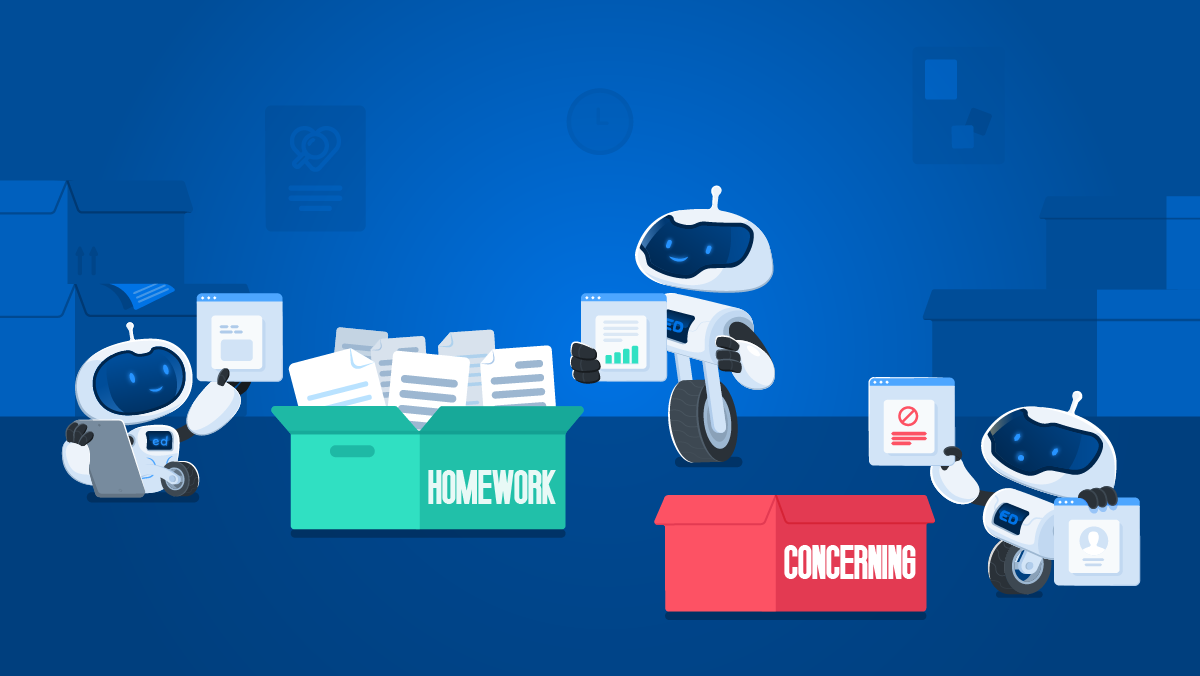When monitoring students’ online activities for signs of safety and wellness risks, false positive alerts are unavoidable. Even if students are completing legitimate research and writing for school assignments, they may need to use terms that will be flagged by a student wellness monitoring system, which will generate alerts.
The problem is that the more false positive alerts monitoring software produces, the more additional and unnecessary work that is created for those responsible for reviewing and validating these alerts. Student monitoring that relies on keyword analysis alone and cannot detect context or sentiment will trigger the most false positive alerts.
To make student wellness monitoring as accurate and reliable as possible — and minimize the workload that false alerts create for busy school staff — Securly Aware has been updated with an Enhanced Homework Detection module.
Enhanced Homework Detection allows Securly Aware to differentiate the use of trigger terms in students’ schoolwork from their other online activities. This latest innovation makes Securly Aware a more reliable and accurate indicator of student safety and wellness concerns for busy district and school teams.
How Does Securly Aware Detect Student Safety & Wellness Concerns?
Securly Aware scans students’ web searches and other online activities to detect signals that a student may be experiencing depression, grief, self-harm, suicide, bullying, violence, and similar threats to their safety and wellbeing. In addition to web searches, Securly Aware scans web browsing activity, emails, and social media posts, as well as Canvas, Google Drive, and OneDrive.
Securly’s AI engine analyzes these activities using keyword analysis in combination with advanced analysis methods, including natural language processing (NLP), sentiment analysis, and image analysis. If it determines that a student activity is concerning, it flags the activity, producing an alert.

Securly’s At-Risk AI engine then analyzes the flagged activity against the student’s historical online searches and other activities. Based on the risk associated with these activities, the student is assigned a Wellness Level, ranging from All Clear to Concerning to High Risk to Critical. Not just a one-time analysis, At-Risk continues to analyze the student’s activities to assess and update their Wellness Level.
Wellness Levels give student services teams invaluable insight into the students who need immediate attention, as well as those who are trending negatively. These student wellness monitoring insights help these typically resource-constrained teams focus on the students who need their support the most.
How Does the Homework Detection Module Work?
Students are commonly assigned homework that requires researching or using terms that typically trigger alerts in student wellness monitoring software. If an assignment references topics like war, violence, suicide, or death, the potential exists that the student’s work will trigger a false positive alert.
A few examples of the type of assignments that could trigger false alerts include:
- A history assignment about World War II
- A research paper about the Civil Rights Movement
- An English essay on Romeo & Juliet
Enhanced Homework Detection builds upon Aware’s proven AI-driven detection workflow. Now when Securly Aware scans Google Drive and OneDrive documents, it also uses large language model-based input parsing to determine if the content being scanned is part of a homework assignment and, if so, doesn’t generate an alert.
How Does Enhanced Homework Detection Minimize False Positive Alerts?
Distinguishing harmless alerts in homework assignments from alerts which indicate legitimate student safety and wellness concerns requires tedious human review. To adequately determine if the activity that triggered the alert belongs to either category, those responsible for managing alerts must do additional investigation.
By differentiating homework assignments, Securly Aware substantially reduces the number of false positive alerts, plus the extra time and effort required to investigate and resolve them. This helps IT administrators and student services staff reduce unnecessary time and effort so they can focus on more important work.
The reduction in false positives also improves the efficiency of the Securly On-Call team. Securly On-Call provides management and risk assessment of alerts for Aware customers. By increasing the accuracy and reliability of Aware alerts, we’re able to maintain a small team of laser-focused and highly qualified analysts.
How Effective is Enhanced Homework Detection?

After completing rigorous testing, the homework detection module was deployed in Securly Aware at the start of December 2023. The number of flagged activities in Google Drive and OneDrive went down by 30% (from 9,511 during the period November 1-7, 2023, to 6,701 for the period December 1-7, 2023).
Learn More about Student Wellness Monitoring with Securly Aware
Innovations like Homework Detection in Securly Aware are just part of the reason K-12 districts and schools rely on Securly to help them keep students safe, secure, and ready to learn.
To see why Chico Unified School District chooses Securly to support their students’ safety and wellness, get the case study.
Curious how Securly could help your district or school?
To learn more, visit our website or contact us.




